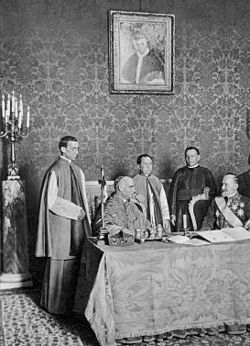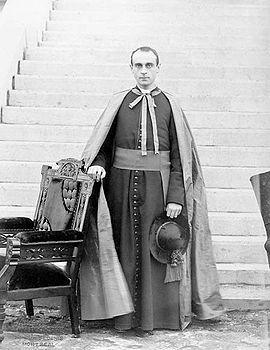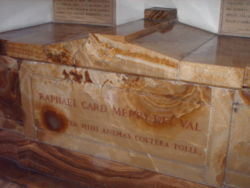- Rafael Merry del Val
-
Rafael Merry del Val y Zulueta (10 October 1865 – 26 February 1930) was a Spanish Roman Catholic cardinal. Before becoming a cardinal, he served as secretary of the conclave that elected Saint Pius X, who is said to have accepted his election as Pope through Merry del Val's encouragement; the same pope later appointed Merry del Val as the Cardinal Secretary of State. Merry del Val composed the Litany of Humility, which continues to be a prayer popularly featured in prayerbooks. His beatification process is ongoing.[citation needed]
Contents
Early life
 Rafael Merry del Val, Eugenio Pacelli and Nicola Canali at the 1914 signing of the Serbian concordat underneath the picture of Pope Pius X.
Rafael Merry del Val, Eugenio Pacelli and Nicola Canali at the 1914 signing of the Serbian concordat underneath the picture of Pope Pius X.
He was born as Rafael María José Pedro Francisco Borja Domingo Gerardo de la Santísma Trinidad Merry del Val y Zulueta at the Spanish Embassy in London, England, to a Spanish diplomat, as the second of four sons. His mother was Sofia Josefa de Zulueta (died 1925), elder daughter of Pedro José de Zulueta, count of Torre Díaz, of the London bank of Zulueta & Co., and his wife, Sophia Ann Wilcox, who was of Scottish and Dutch ancestry.
The Zuluetas were an old Basque family ennobled as counts de Torre Díaz in the nineteenth century. His father was Rafael Merry del Val (1831–1917), Marquis of Merry del Val, secretary to the Spanish legation in London, a monarchist supporter of Alfonso XII and nobleman. The del Vals were an Aragonese family originally from Zaragoza, claiming descent from a twelfth-century Breton crusader; the name of Merry came from a line of Irish merchants from County Waterford, Ireland, who settled in the late eighteenth century in Seville. Merry del Val's elder brother Alfonso, marquess of Merry del Val (b. 1864), was Spanish ambassador to Great Britain between 1913 and 1931.
Education
Del Val lived in the United Kingdom until 1878. His mother's family owned a large villa in Boscombe, a leafy suburb of Bournemouth. He attended prep school in Bournemouth where the Jesuits were establishing what were to become five parishes and a school. He received his first Holy Communion at the Sacred Heart Church on Richmond Hill and later enrolled at the northern seminary of Ushaw College in county Durham. He was ordained a priest on 30 October 1888 after receiving a doctorate in philosophy at the Pontifical Gregorian University. He later received a doctorate in theology and then a licentiate in canon law.
Archbishop and cardinal
In 1891 he became a privy chamberlain and member of the Pontifical Family, having served as a secretary in nunciatures.
Entrusted by Leo XIII with the question of the validity of Anglican orders – at the uncertain beginning of ecumenical relations – he led the Holy See to the negative response made official in September 1896 with the bull Apostolicae Curae of which he was the main architect. On the basis of practice that had stood for three hundred years and an exhaustive historical investigation, Leo XIII confirmed the "nullity" of the "ordinations carried out with the Anglican rite", thereby denying the apostolic succession of those bishops.[1]
His continued service in diplomatic posts and in the Roman Curia saw him named Apostolic Delegate to Canada and domestic prelate in 1897 and then president of the Pontifical Academy of Ecclesiastical Nobles (an institution connected to the Roman Curia, in charge of the formation of priests who are to serve in the Diplomatic Corps of the Holy See) in 1899. He was appointed Titular Archbishop of Nicaea on 19 April 1900 and consecrated a bishop by Mariano Rampolla del Tindaro, Cardinal Secretary of State of Pope Leo XIII.
In 1902 he was the papal representative to the coronation of King Edward VII, accompanied by Eugenio Pacelli.
He served as secretary of the conclave of 1903 that elected Pope Pius X. By a coincidence, the secretary of the Sacred Consistorial Congregation, who was also the secretary of the College of Cardinals and therefore of the conclave, had died almost at the same time as Leo XIII. In haste, the cardinals chose as his successor Archbishop Merry del Val, who had been ordained a bishop only three years before.[1]
The choice had been made from a pool of three names. The two rejected candidates were the substitute for General Affairs of the Secretariat of State, Giacomo Della Chiesa, and Pietro Gasparri, who was then serving as the secretary for Extraordinary Ecclesiastical Affairs. The preference shown to the youngest and least experienced of the three was interpreted as the first defeat of the Rampolla coalition, and a foreshadowing of what would happen at the conclave.[1]
Austrian veto at papal conclave
According to Rafael Merry del Val, during the conclave of 1903, in which he served in the role of Secretary of the Conclave, Cardinal Jan Puzyna de Kosielsko of Krakow came to see him, demanding to announce his veto against Cardinal Rampolla in the name of Emperor Franz Joseph I of Austria-Hungary. Archbishop Merry Del Val protested and refused to even accept the document, which, in the heat of the debate fell on the floor and was picked back up by Cardinal Puzyna.[2]. Cardinal Puzyna announced the veto anyway, in the presence of the Cardinals gathered in the Sistine Chapel. The College of Cardinals was outraged. Rampolla, according to Merry del Val, actually gained votes after the veto. Later, he opined to Ludwig von Pastor that Cardinal Rampolla never had a chance, because the cardinals wanted a new direction after the pontificate of Pope Leo XIII.[2] After his election, the new Pope Pius X decreed automatic excommunication on anyone who should try to influence a conclave with a threat or veto.[3]
Cardinal Secretary of State
Styles of
Rafael Merry del Val
Reference style His Eminence Spoken style Your Eminence Informal style Cardinal After a two month trial period, Pius X named him pro-Secretary of State. That November he became the first cardinal elevated by the Pope (a traditional reward to the secretary of a conclave), becoming Cardinal-Priest of Santa Prassede and full Secretary of State, replacing Cardinal Rampolla del Tindaro, who was moved to the post of Secretary of the Holy Office.
The praise that Pope Pius addressed to him on 11 November 1903, the day he received the cardinal's hat, is so unusual, that it deserves to be quoted in full: "The good odor of Christ, lord cardinal, that you have spread in every place, even in your temporary dwelling, and the many works of charity to which you have dedicated yourself constantly in your priestly ministry, especially in this our city of Rome, have won for you, with admiration, universal esteem." [1]
From 1907s Pascendi Dominici Gregis until 1914 Merry del Val also was active in combatting modernism among the clergy, especially the university professors.
However, he obviated an official canonic acknowledgement of Sodalitium Pianum (in France known as "La Sapinière") and showed a certain distance to the extensive activiuties of Umberto Benigni; supported by voices from Germany protesting against an 'integralistic conspiracy'. In 1911, Sodalitium Pianum left at their own will the structure of the Secretariat of State.[4]
Among his diplomatic achievements was the signing of a Concordat with Serbia barely four days before the assassination of the Austrian Heir-Apparent, Franz Ferdinand, in Sarajevo on June 28th 1914 plunged Europe into the First World War. Merry del Val recorded that the "breakthrough" in the difficult negotiations with Belgrade came on the Feast of the Sacred Heart. The Pope and his Cardinal Secretary of State were fully aware that war was imminent. Pius X had already warned a departing Brazilian Ambassador a year earlier that Europe would not "get through 1914" without a major conflagration. The Concordat was able to ensure that in the likely event of Serbia expanding her territories at the expense of Austria-Hungary, the rights of Catholics in those lands would be preserved.
He remained Secretary of State throughout the pontificate of Pius X, but when Pope Benedict XV, an old associate of Rampolla, was elected in the conclave of 1914, he was not reappointed. Benedict XV in fact appointed as his Cardinal Secretary of State, first Domenico Ferrata, who died almost immediately, and then Pietro Gasparri. Thus at the head of the Church were the two bishops – Della Chiesa (now Pope Benedict XV) and Gasparri – who had been leapfrogged by Merry del Val on the eve of the conclave in 1903.
However, Benedict XV appointed Merry del Val as secretary of the Supreme Sacred Congregation of the Holy Office on 14 October 1914.
After being Secretary of State, the Congregation was considered an important though lesser assignment. The Pope did not appoint him as Prefect, because at the time the Popes themselves were Prefects of the Holy Office. The post of Secretary was then the highest ranking office in the Dicastery. Merry del Val as secretary was responsible for running the daily affairs of the Holy Office.
Merry del Val reportedly explained Pope Pius's policy of non possumus to Theodore Herzl and his emerging movement of Zionism, saying that as long as the Jews deny the divinity of Christ, the Church certainly could not make a declaration in their favor.[5]To the British Zionist and Catholic diplomat Mark Sykes who visited him on the same topic he was more supportive, indicating that the Vatican would look benignly on the project.
After the death of Pope Benedict XV (22. January 1922), Cardinal Merry del Val was retained by Pope Pius XI in the role of Secretary of the Holy Office, a post Merry del Val held until his death in 1930.
He died while being operated on for appendicitis.[6]
Cause of Beatification
A cause of beatification of Merry del Val was opened in 1953, under the Pontificate of Pius XII. Merry del Val, therefore, enjoys the title "Servant of God".
Works (partial list)
- The Truth of Papal Claims (St. Louis, Mo, 1902)
Notes
- ^ a b c d Here's a Perfect Secretary of State. But from a Century Ago
- ^ a b Von Pastor, 696
- ^ Von Pastor, 697
- ^ Thomas Marschler, see article 'Umberto Benigni'
- ^ Catholicism, France and Zionism: 1895-1904
- ^ The Times, Feb 27, 1930; pg. 14.
External links and references
- Entry at Catholic-Hierarchy.org site
- Biography at The Cardinals of the Holy Roman Church site
- Cardinal Merry del Val
Catholic Church titles Preceded by
Mariano Rampolla del TindaroCardinal Secretary of State
1903-1914Succeeded by
Domenico FerrataPreceded by
Mariano Rampolla del TindaroArchpriest of St. Peter's Basilica
1914-1930Succeeded by
Eugenio PacelliPreceded by
Domenico Cardinal FerrataSecretary of the Supreme Sacred Congregation of the Holy Office
14 October 1914 - 26 February 1930Succeeded by
Donato Cardinal SbarrettiCategories:- 1865 births
- 1930 deaths
- People from London
- Spanish people of Dutch descent
- Spanish people of Irish descent
- Spanish people of Scottish descent
- English people of Dutch descent
- British people of Basque descent
- English people of Spanish descent
- Spanish cardinals
- Diplomats of the Holy See
- 20th-century Roman Catholic archbishops
- Venerated Catholics
- Spanish nobility
- Roman Catholic titular archbishops
- 20th-century venerated Christians
- Cardinal Secretaries of State
- Members of the Holy Office
- Alumni of the Pontifical Ecclesiastical Academy
- Alumni of the Pontifical Gregorian University
Wikimedia Foundation. 2010.


